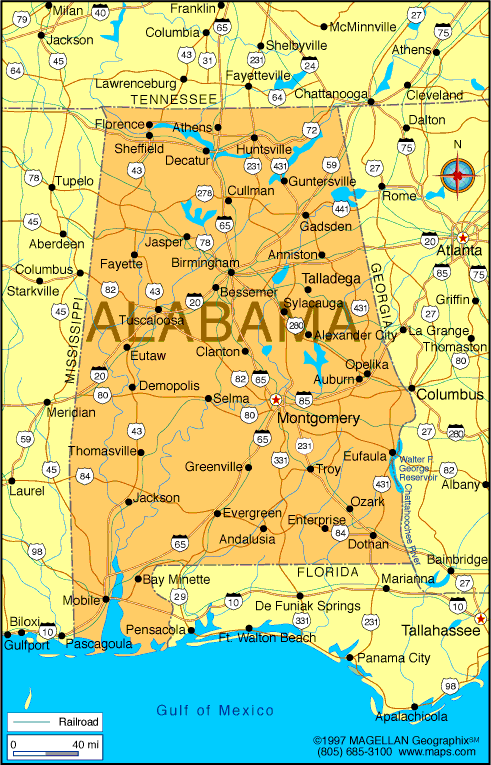Located in the Southeast region of the United States, Alabama is a state rich in history, culture, and natural beauty. Known as the "Yellowhammer State", it played an important role in both the US Civil War and the Civil Rights Movement, making it an important part of the country's historical fabric. From the boundary of the Gulf of Tennessee, Georgia, Florida, Mississippi, and Mexico, Alabama claims diverse geography, from Appalachian foothills in the north to sandy beaches in the south.
Its capital is Montgomery, while Birmingham stands as its largest city and economic center. Alabama is also home to important educational institutions and a growing aerospace industry. Alabama affects American politics, culture, and education, with a deep sense of pride and a deep sense of identity.
Check Out: All About Colorado: History, Map, Education, Geography and Interesting Facts
Interesting Facts About Alabama
Here are some of the basic features and details about Alabama:
| Feature | Details |
| Nickname | The Yellowhammer State |
| State Bird | Yellowhammer (Northern Flicker) |
| State Flower | Camellia |
| State Tree | Longleaf Pine |
| Motto | "Audemus jura nostra defendere" (We dare defend our rights) |
| Time Zone | Central Time (CST/CDT) |
| Population | 5 million (as of 2024 estimate) |
| Economy Highlights | Aerospace, steel, agriculture, automotive (Hyundai, Mercedes-Benz), tourism |
Flag of Alabama

Source: Alabama.gov
Adopted officially in 1895, the flag of the state of Alabama is simultaneously simple and unique. It features a bold red St. Andrew’s cross, or cross, in the shape of an X, on a plain white field.
Another unique factor of the Alabama flag is that it is required to be square, not rectangular, like most other U.S. state flags. The square format makes the Alabama flag stand out as a part of Alabama’s history and heritage.
Capital of Alabama
Montgomery, the capital of Alabama, is a city steeped in history and culture. Set along the Alabama River, Montgomery has shaped history in the United States, especially during the 1950s and 1960s, during the Civil Rights Movement. Dr. Martin Luther King Jr. led the Montgomery Bus Boycott here, which helped to focus the attention of the nation on the struggle for equality.
Montgomery is home to the Alabama State Capitol, Civil Rights Memorial, and a number of museums dedicated to the city's legacy. Today, Montgomery continues to marry its historic legacy with a growing economy, a vibrant arts community, and Southern charm.
Geography of Alabama

Source: Alabama.gov
Alabama is located in the southeast region of the United States and covers an area of approximately 52,420 square miles, making it the 30th largest state. The US has a diverse landscape in the state consisting of mountains, rolling grounds, rivers, and coastal Terai. The North Alabama Appalachian mountain range is part of the rugged terrain and sightseeing with the Cumberland Plateau.
Area: 52,420 sq. miles (30th largest U.S. state)
Rivers: Tennessee River, Alabama River, Mobile River
Natural Resources: Timber, coal, limestone, natural gas
Climate: Humid subtropical, hot summers and mild winters
Alabama's geography is varied; its topography ranges from the foothills of the Appalachian Mountains in the northern part of the state to the Gulf Coast in the south.
The northern portion of Alabama consists of hilly, rugged terrain with ridges and valleys associated with the southern extent of the Appalachian Mountains, resulting in spectacular topography as well as extensive resources.
In the central region, Alabama morphs into the Piedmont Plateau, featuring rolling hills with rich soils that have been home to historical farmland.
Towards the southern part of the state, the Coastal Plain is found, similarly a broad, flat region that gently slopes down to the Gulf of Mexico. Along the Gulf Coast, sandy beaches, wetlands, and estuaries present a unique coastal landscape.
History of Alabama
The history of Alabama lies deeply in the original American culture, colonial expansion, the Civil War, and the Civil Rights Movement. Before European contact, Alabama was home to indigenous tribes such as the Creek, Cherokee, Choctaw, and Chickasaw. The Spanish explorers arrived in the 16th century, followed by the French, who founded the city in 1702 as the capital of French Louisiana.
The region's control later moved to the British and then the Spanish again before becoming a part of the United States in the early 19th century.
Alabama became the 22nd U.S. state on 14 December 1819. It was a prominent member of the Confederacy during the American Civil War, in which Montgomery served as the Confederate Capital.
In the 20th century, Alabama became a central battleground in the civil rights movement, which was marked by events such as the Montgomery Bus Boycott (1955) and the Selma to Montgomery March (1965). Today, Alabama is recognized for its rich cultural heritage, historical sites, and contributions to the space and defense industries.
Education in Alabama
School System: Public and private K-12 schools managed by the Alabama State Department of Education
Famous for: Strong football culture (especially SEC college football)
Literacy Rate: Improving over decades; initiatives underway for rural access
Education in Alabama is ruled by the Alabama State Education Department, which oversees public K-12 schools across the state. The system includes traditional public schools, charter schools, and private institutions.
Efforts have been made in recent years to improve literacy rates, expand STEM programs, and increase access to education in rural areas.
Alabama is the home of several major universities, including Alabama University, Auburn University, and Alabama University Birmingham (UAB), which are known for their medical and research programs.
Economy of Alabama
The economy of Alabama is diverse and has developed considerably from its historical dependence on Agriculture. While cotton and poultry farming remain important, modern Alabama Automotive Manufacturing, Aerospace, Steel Production, and Technology are strong industries.
Major Automobile Companies like Mercedes-Benz, Hyundai, Honda, and Mazda-Toyota have large manufacturing plants in the state, which makes Alabama to top U.S. state in auto production.
The Aerospace Sector is focused in Huntsville, known as "Rocket City", hosting NASA's Marshal Space Flight Center and major defense contractors. Supports International Trade and Shipping.
The Gulf Coast also contributes to the tourism economy, run by beaches and historical sites. Alabama's economy continues through industrial expansion and employment generation in emerging technical sectors.
Comments
All Comments (0)
Join the conversation